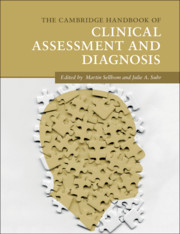Book contents
- The Cambridge Handbook of Clinical Assessment and Diagnosis
- The Cambridge Handbook of Clinical Assessment and Diagnosis
- Copyright page
- Contents
- Figures
- Tables
- Contributors
- Acknowledgments
- 1 Introduction to the Handbook of Clinical Assessment and Diagnosis
- Part I General Issues in Clinical Assessment and Diagnosis
- Part II Specific Clinical Assessment Methods
- Part III Assessment and Diagnosis of Specific Mental Disorders
- 21 Assessment of Childhood Neurodevelopmental Disorders
- 22 Assessment of Childhood Disruptive Behavior Disorders and Attention-Deficit/Hyperactivity Disorder
- 23 Assessment of Depressive Disorders and Suicidality
- 24 Assessment of Anxiety Disorders and Obsessive-Compulsive Disorder
- 25 Assessment of Trauma- and Stressor-Related Disorders
- 26 Assessment of People with Psychotic and Bipolar Disorders
- 27 Assessment of Eating Disorders
- 28 Assessment of Substance Use Disorders
- 29 Assessment of Personality Disorder
- 30 Neuropsychological Assessment of Dementia
- 31 Assessment of Traumatic Brain Injuries
- Part IV Clinical Assessment in Specific Settings
- Index
- References
28 - Assessment of Substance Use Disorders
from Part III - Assessment and Diagnosis of Specific Mental Disorders
Published online by Cambridge University Press: 06 December 2019
- The Cambridge Handbook of Clinical Assessment and Diagnosis
- The Cambridge Handbook of Clinical Assessment and Diagnosis
- Copyright page
- Contents
- Figures
- Tables
- Contributors
- Acknowledgments
- 1 Introduction to the Handbook of Clinical Assessment and Diagnosis
- Part I General Issues in Clinical Assessment and Diagnosis
- Part II Specific Clinical Assessment Methods
- Part III Assessment and Diagnosis of Specific Mental Disorders
- 21 Assessment of Childhood Neurodevelopmental Disorders
- 22 Assessment of Childhood Disruptive Behavior Disorders and Attention-Deficit/Hyperactivity Disorder
- 23 Assessment of Depressive Disorders and Suicidality
- 24 Assessment of Anxiety Disorders and Obsessive-Compulsive Disorder
- 25 Assessment of Trauma- and Stressor-Related Disorders
- 26 Assessment of People with Psychotic and Bipolar Disorders
- 27 Assessment of Eating Disorders
- 28 Assessment of Substance Use Disorders
- 29 Assessment of Personality Disorder
- 30 Neuropsychological Assessment of Dementia
- 31 Assessment of Traumatic Brain Injuries
- Part IV Clinical Assessment in Specific Settings
- Index
- References
Summary
Addressing important problems and processes in the assessment of substance use disorders (SUDs), this chapter reviews the types of information necessary for a formal diagnosis of a DSM-5 SUD. In addition, the chapter discusses seven assessment areas that must be examined if a given case is to be well evaluated. These include clinical history, strength of dependence syndrome, impaired volitional control, craving, neuroadaptation, negative consequences and pathological patterns, and stage of change. The origin and research background of each of these constructs are briefly outlined, a favored assessment tool for each is reviewed in detail, and alternative measures are also suggested. The assessment of SUDs is a multidimensional, complex process for which many excellent tools have been, and are still being, developed.
- Type
- Chapter
- Information
- The Cambridge Handbook of Clinical Assessment and Diagnosis , pp. 385 - 397Publisher: Cambridge University PressPrint publication year: 2019

